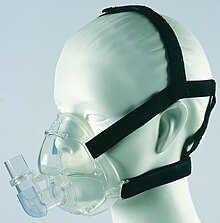Sleep apnea
Sleep apnea (or Sleep apnoea) is a problem certain people, typically obese middle aged men, have. When they sleep, they may stop breathing for short periods of time. These periods can last for 10 seconds or more. 3-4 breaths are missed. As a result of this happening during sleep, those affected are often tired during the day. Mainly because such people also tend to have microsleep, they should not drive vehicles. Sleep apnea is a treatable disease.
Sleep apnea occurs when the muscles in the back of the throat relax too much to allow normal breathing. These muscles support structures including the back of the roof of the mouth (soft palate), the triangular piece of tissue hanging from the soft palate (uvula), the tonsils, and the tongue.
When the muscles relax, the airway narrows or closes when breathe in, hampering the breathing for 10 seconds or longer. This will lower the level of oxygen in the blood and cause a buildup of carbon dioxide.
Signs and symptoms
[change | change source]Signs and symptoms of sleep apnea are listed.
- Observed episodes or periods of stopped breathing during sleep (>15 episodes in 1 hour indicates sleep apnea), followed by abrupt awakenings with choking and gasping, which then ends the episode
- Loud snoring
- Lowering of concentration
- Morning headache
- Difficulty concentrating during the day
- Mood changes, such as depression or irritability
- High blood pressure
- Decreased libido
- Awakening with a dry mouth or sore throat
Finding out if someone has sleep apnea
[change | change source]People can ask their partner or family member if they are breathing strangely when they are sleeping. Usually the patients partner or carer is the person who takes them to get checked. The doctor might test someone overnight in special monitored rooms the patient sleeps in, monitoring them with a camera and machines to watch their breathing and other signs, to check for episodes of sleep apnea.
Treatment
[change | change source]
- In case the patient is obese, losing weight improves sleep apnea.
- Fixing the environment where they sleep
- Continuous positive airway pressure(CPAP)
- Expiratory positive airway pressure(EPAP)
- Circular breathing technique (It makes muscle of the upper airway stronger, so airway remains opening when sleeping. Playing didgeridoo is good for learning this technique.[1]
Complication
[change | change source]Diseases which may complicate sleep apnea are: obesity, high blood pressure, hyperlipidaemia, arrhythmia, polyemia, ischemic heart disease, cerebrovascular disease, diabetes etc.
Sleep apnea is a risk factor of arteriosclerotic disease.[2][3]
Effects
[change | change source]- Daytime sleepiness (narcolepsy)
- Depression
- Less concentration
- Snoring
- Headache when waking up
Where there are no observers, it may take time to discover this condition. When especially subjective symptoms are weak, the state will get worse gradually and it will start a serious problem.
Other websites
[change | change source]References
[change | change source]- ↑ Puhan MA, Suarez A, Lo Cascio C; et al. (2005). "Didgeridoo playing as alternative treatment for obstructive sleep apnea syndrome: randomised controlled trial". BMJ. 332 (7536): 266–70. doi:10.1136/bmj.38705.470590.55. PMC 1360393. PMID 16377643.
{{cite journal}}: CS1 maint: multiple names: authors list (link) - ↑ "Sleep Apnea Machines". Archived from the original on 2017-01-30. Retrieved 2015-10-28.
- ↑ "Is it snoring or sleep Apnea?". Archived from the original on 2016-03-16. Retrieved 2015-10-28.
